Expert Guide to Safe Machine Washing: From Newborn Care to Toddler Transition
When you welcome your first baby home, those tiny clothes pile up faster than you might expect. Between spit-up, diaper blowouts, and food mishaps, you’ll quickly realize that washing baby clothes becomes a daily task. You can safely wash most baby clothes in your regular washing machine using the right techniques and gentle detergents.
While some special fabrics need extra care, your washing machine handles the majority of baby laundry effectively. The key lies in choosing appropriate detergents, water temperatures, and wash settings that protect your baby’s sensitive skin while keeping clothes clean and soft.
Table of Contents
Can You Wash Baby Clothes in a Washing Machine?
Yes, it’s perfectly safe to wash your baby’s clothing, linens, cloth diapers, and blankets in your washing machine. The machine itself won’t damage baby clothes (unless you’re dealing with delicate items like hand-sewn silk christening gowns). However, what you put in the machine alongside those clothes matters significantly.
Modern washing machines offer gentle cycles specifically designed for delicate items, making them ideal for baby clothing. Using proper detergents and settings ensures your baby’s clothes come out clean, soft, and free from irritants.
Here’s a quick visual guide to answer this common question and highlight the key benefits:
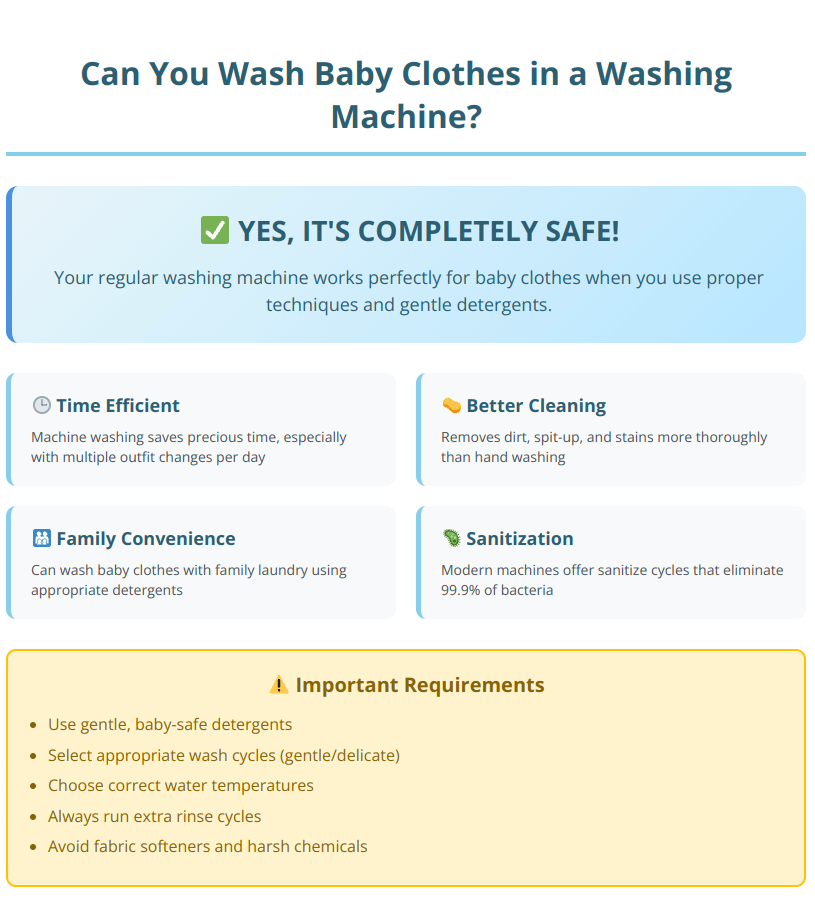
As you can see, machine washing is not only safe but often more effective than hand washing when done correctly.
Benefits of Machine Washing Baby Clothes
- Time Efficiency: Machine washing saves precious time, especially when dealing with multiple outfit changes per day. You can wash larger loads efficiently compared to hand washing each item.
- Better Cleaning Power: Washing machines remove dirt, spit-up, and stains more thoroughly than hand washing. The agitation and rinse cycles work together to eliminate bacteria and odors effectively.
- Convenience for Busy Parents: You can wash baby clothes with other family laundry (using appropriate detergents), making laundry management simpler during those hectic early months.
- Sanitization Options: Many modern machines include sanitize cycles that use extra-hot water to eliminate 99.9% of common household bacteria, providing additional protection for baby items.
Preparation Before Washing Baby Clothes
Proper preparation is crucial for safe and effective baby laundry. Follow this step-by-step guide:
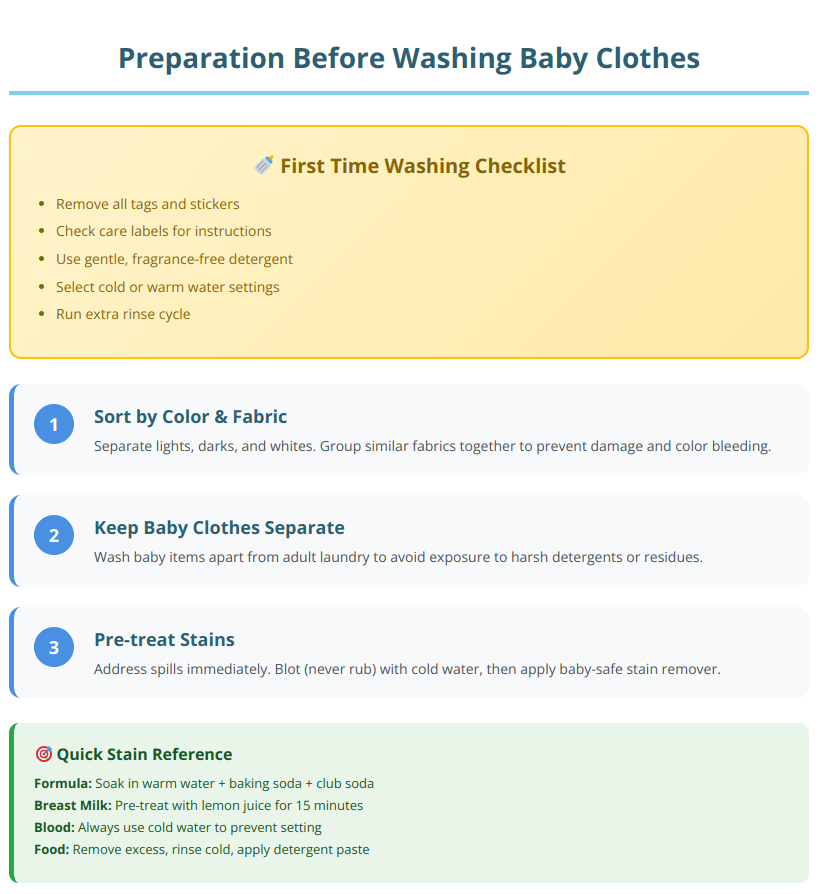
Taking these preparation steps ensures your baby’s clothes come out clean, safe, and free from irritants.
Washing your baby’s clothes for the first time is more than just a practical task, it’s often an emotional milestone for new parents. This sweet moment represents preparing for your little one’s arrival and taking those first steps into parenthood.
Many parents find that first wash to be surprisingly meaningful. It’s perfectly normal to feel emotional about these small but significant preparations. Remember, you’re not just cleaning clothes, you’re creating a safe, comfortable environment for your baby’s arrival.
How to Wash Newborn Clothes for the First Time
Always wash new baby clothes before your baby wears them. This initial wash removes manufacturing chemicals, fabric treatments, and any allergens that may have accumulated during storage or shipping.
For first-time washing:
- Remove all tags and stickers (they can leave permanent stains if left on)
- Check care labels for specific instructions
- Sort by color and fabric type
- Use a gentle, fragrance-free detergent
- Select cold or warm water settings
- Run an extra rinse cycle to remove all detergent residue
Sorting Baby Laundry
- Color Separation: Sort lights from darks and whites to prevent color bleeding, especially important for new clothes during their first few washes.
- Fabric Types: Group similar fabrics together. Cotton items can typically handle slightly different settings than delicate synthetic blends.
- Soil Level: Separate heavily soiled items (like bibs with food stains) from lightly soiled clothes. This prevents cross-contamination and allows for appropriate treatment.
- Keep Baby Clothes Separate: Wash baby items apart from adult laundry to avoid exposure to harsh detergents or residues from heavily soiled adult clothing.
Pre-Treating Stains
Baby clothes face unique staining challenges. Here’s how to handle common stains:
- Formula Stains: Soak in warm water (not hot, which can set the stain), sprinkle baking soda over the area, pour club soda on top, and scrub gently with a soft toothbrush. Let sit for 10 minutes before washing.
- Breast Milk Stains: Pre-treat with lemon juice or your preferred stain remover. Let it sit for 15 minutes before washing.
- Blood Stains: Always use cold water to prevent setting. Rinse immediately with cold water, then apply detergent directly to the stain.
- Food Stains: Remove excess food, rinse with cold water, then apply a paste of detergent and water. Let it sit before washing.
For comprehensive guidance on identifying and treating specific baby stains, check out our detailed Stain Identification and Treatment Guide. This resource covers everything from formula and food stains to diaper blowouts with step-by-step removal techniques.
Choosing the Right Detergent for Baby Clothes
Choosing the right detergent for your baby’s sensitive skin doesn’t have to be overwhelming. Use our interactive comparison tool to find the perfect product based on your specific needs and budget:
🧼 Baby Detergent Comparison & Shopping Guide
Find the perfect gentle detergent for your baby’s sensitive skin with expert recommendations and live pricing
🎯 Find Your Perfect Match
What’s most important for your baby?

Babyganics 3X Baby Laundry Detergent
Plant-based formula, fragrance free, 60 fl oz
- 100% plant-based cleaning ingredients
- 3X concentrated formula for fewer plastic bottles
- Fragrance-free and dye-free formula
- No sulfates, phosphates, or optical brighteners
- Pediatrician and dermatologist tested
- Safe for cloth diapers and septic systems
Why We Recommend This
Top-rated by parents for removing tough baby stains including spit-up and formula. Plant-based formula is gentle on sensitive skin while providing powerful cleaning. Excellent value with concentrated formula.

Dreft Stage 1 Newborn Liquid
#1 pediatrician recommended, 50 fl oz
- #1 pediatrician recommended baby detergent brand
- Specifically formulated for newborn skin (0-12 months)
- Hypoallergenic and dye-free
- EPA Safer Choice certified
- No added chlorine bleach or phosphates
- Gentle enough for cloth diapers
Why Pediatricians Choose This
Trusted by hospitals and pediatricians for over 80 years. Specifically designed for babies under 12 months with the most gentle formula available. Effectively removes milk and spit-up stains.

Puracy Natural Liquid Laundry Detergent
10X concentrated with pump, 16 fl oz (64 loads)
- 99.5% natural and plant-based ingredients
- 10X concentration – most concentrated on the market
- Convenient pump bottle design (no measuring)
- Doctor-formulated for sensitive skin
- 4 plant-based stain-fighting enzymes
- Biodegradable and eco-friendly
Why Eco-Conscious Parents Love This
Ultra-concentrated formula reduces packaging waste by 80%. Pump bottle eliminates measuring and spills. Doctor-developed for families with eczema and sensitivities.

Seventh Generation Free & Clear
Plant-based concentrated formula, 50 fl oz
- Made with 94% bio-based ingredients
- Hypoallergenic and fragrance-free
- EPA Safer Choice certified
- Biodegradable cleaning ingredients
- No dyes, optical brighteners, or synthetic fragrances
- Leaping Bunny certified cruelty-free
Why Environmentally Conscious Families Choose This
EPA certified safe ingredients with excellent environmental credentials. Widely available and budget-friendly with effective cleaning power. Great entry-level natural detergent.

Tide Free & Gentle HE Liquid
Powerful cleaning, gentle formula, 84 fl oz
- Free of dyes, perfumes, and phosphates
- Recognized by National Eczema Association
- EPA Safer Choice certified
- Works in both HE and standard machines
- Powerful stain-fighting enzymes
- Hypoallergenic formula
Why This Offers Great Value
Trusted Tide cleaning power at an affordable price. Excellent for families transitioning from baby-specific detergents. Superior stain removal with gentle, hypoallergenic formula.

all Baby Gentle Laundry Detergent
Hypoallergenic for sensitive skin, 75 fl oz
- 2X concentrated formula
- Hypoallergenic and dye-free
- Free from perfumes and harsh chemicals
- Suitable for sensitive skin
- Works in HE and standard machines
- Budget-friendly option
Why Budget-Conscious Parents Choose This
Excellent value at under $0.10 per load while maintaining gentle, hypoallergenic properties. Great option for families looking for effective baby-safe cleaning without premium pricing.
Affiliate Disclosure: This page contains affiliate links. We earn a small commission if you purchase through our links, at no additional cost to you. This helps us provide free, comprehensive guides for parents. All recommendations are based on genuine testing and research. Prices and availability are subject to change.
This interactive tool helps you make an informed decision based on real testing data, customer reviews, and expert recommendations. Remember, the best detergent is one that keeps your baby's clothes clean while protecting their sensitive skin.
For a detailed side-by-side comparison of all top baby detergents with live ratings and pricing, use our Interactive Baby Detergent Comparison Chart. This tool helps you filter products by your specific needs and compare features, safety ratings, and cost per load.
What Makes a Detergent Baby-Safe?
- Fragrance-Free Formula: Look for "fragrance-free" rather than "unscented." Unscented products often contain masking chemicals that can irritate sensitive skin.
- Dye-Free Options: Dyes serve no cleaning purpose and can cause skin reactions in sensitive babies.
- Hypoallergenic Certification: These products undergo testing to minimize allergic reactions.
- Plant-Based Ingredients: Many effective baby detergents use plant-derived cleaning agents instead of harsh synthetic chemicals.
Do You Really Need Special Baby Detergent?
For most babies, yes. According to the American Academy of Pediatrics, newborns have extra-sensitive skin, making it essential to wash all new clothes before use. While some families successfully use the same detergent for everyone's laundry, the AAP notes that many detergents contain chemicals and fragrances that can irritate baby's delicate skin. However, some families do successfully use gentle, fragrance-free adult detergents.
At what age can you switch to regular detergent? Most pediatricians suggest continuing baby-safe detergents until your child is at least 12-18 months old, when their skin becomes less sensitive.
Can I Use Ariel or Other Regular Detergents?
Standard detergents like Ariel contain enzymes and fragrances that may be too harsh for baby skin. If you choose to use regular detergent, select the "Free & Clear" or "Sensitive" versions and always run an extra rinse cycle.
Water Temperature and Wash Settings
Choosing the right water temperature and wash settings is crucial for both cleaning effectiveness and fabric protection:
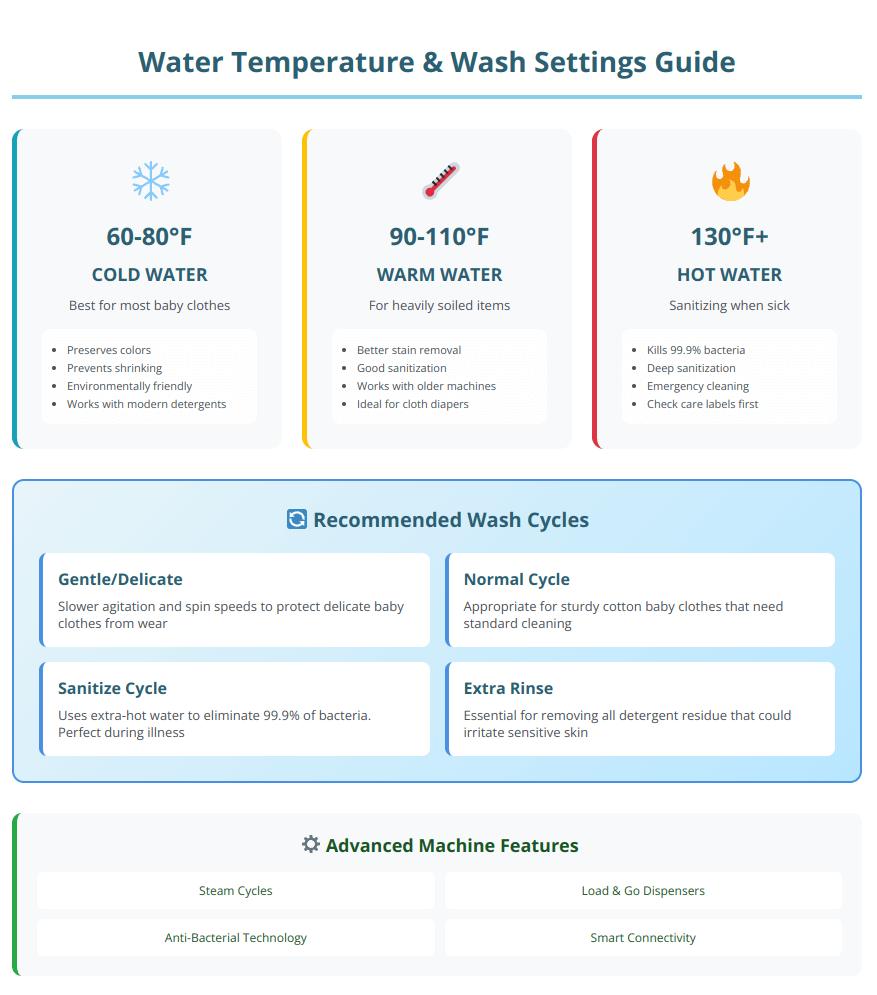
Remember, when in doubt, always check the care label and err on the side of gentleness for baby clothes.
What Temperature Should You Use?
- Cold Water (60-80°F): Best for most baby clothes. Preserves colors, prevents shrinking, and is environmentally friendly. Modern detergents work effectively in cold water.
- Warm Water (90-110°F): Ideal for heavily soiled items or when dealing with illness. Warm water helps remove stubborn stains and provides better sanitization.
- Hot Water (130°F+): Reserve for sanitizing when someone is sick or for items that can withstand high temperatures. Always check care labels first.
Not sure which temperature is right for your specific situation? Our Water Temperature Selection Guide asks a few simple questions about what you're washing and provides personalized temperature recommendations with detailed explanations.
Recommended Washing Machine Settings
- Gentle/Delicate Cycle: Uses slower agitation and spin speeds to protect delicate baby clothes from wear and tear.
- Normal Cycle: Appropriate for sturdy cotton baby clothes that need standard cleaning.
- Sanitize Cycle: Available on many modern machines, this cycle uses extra-hot water to eliminate 99.9% of bacteria. Consumer Reports testing confirms that sanitizing cycles can reach high enough temperatures for the required amount of time to adequately kill germs on fabrics. Perfect for items exposed to illness or heavily soiled cloth diapers.
Advanced Washing Machine Features for Baby Clothes
- Extra Rinse Option: Removes all detergent residue that could irritate sensitive skin. Always use this feature for baby laundry.
- Steam Cycles: Help remove stubborn stains while sanitizing clothes naturally.
- Load & Go Dispensers: Automatically measure detergent for each load, preventing overdosing that can leave residue.
- Anti-Bacterial Technology: Some newer machines include silver ion or other antibacterial treatments in their wash cycles.
Want to know if your washing machine has the right features for baby clothes? Try our Washing Machine Compatibility Checker to get a personalized assessment of your machine's capabilities and specific recommendations for optimal baby laundry care.
Special Considerations for Baby Laundry
Baby laundry requires special attention beyond regular washing. Here are the key considerations:
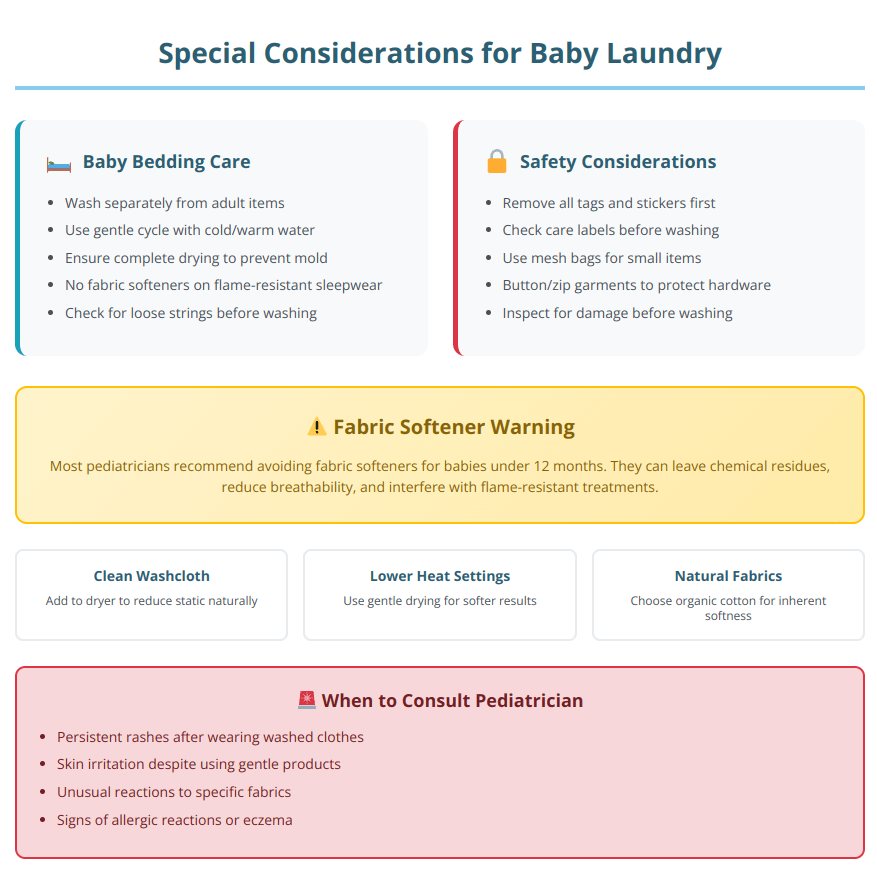
These special considerations help protect your baby's sensitive skin and ensure their clothes remain safe and comfortable.
Washing Baby Bedding and Blankets
- Separate Washing: Always wash baby bedding separately from adult items to prevent exposure to harsh chemicals.
- Gentle Cycle: Use cold or warm water with a gentle cycle to prevent damage to delicate fabrics.
- Complete Drying: Ensure bedding is completely dry before use to prevent mold or mildew growth that could affect your baby's health.
- No Fabric Softeners: Baby bedding often has flame-resistant coatings that fabric softeners can damage.
Fabric Softener and Baby Clothes
Generally Avoid: Most pediatricians recommend avoiding fabric softeners for baby clothes, as they can:
- Leave chemical residues that irritate skin
- Reduce fabric breathability
- Interfere with flame-resistant treatments on sleepwear
Alternatives for Softness:
- Add a clean washcloth to the dryer to reduce static
- Use lower heat settings when drying
- Choose naturally soft fabrics like organic cotton
Is Fairy Fabric Softener Safe for Babies?
While Fairy offers "gentle" formulations, most pediatric dermatologists recommend avoiding all fabric softeners for babies under 12 months. If you choose to use fabric softener, select fragrance-free, hypoallergenic versions and always run an extra rinse cycle.
Washing Machine Cycles Explained for Baby Clothes
Understanding which washing machine cycle to use can make a significant difference in cleaning effectiveness and fabric care:
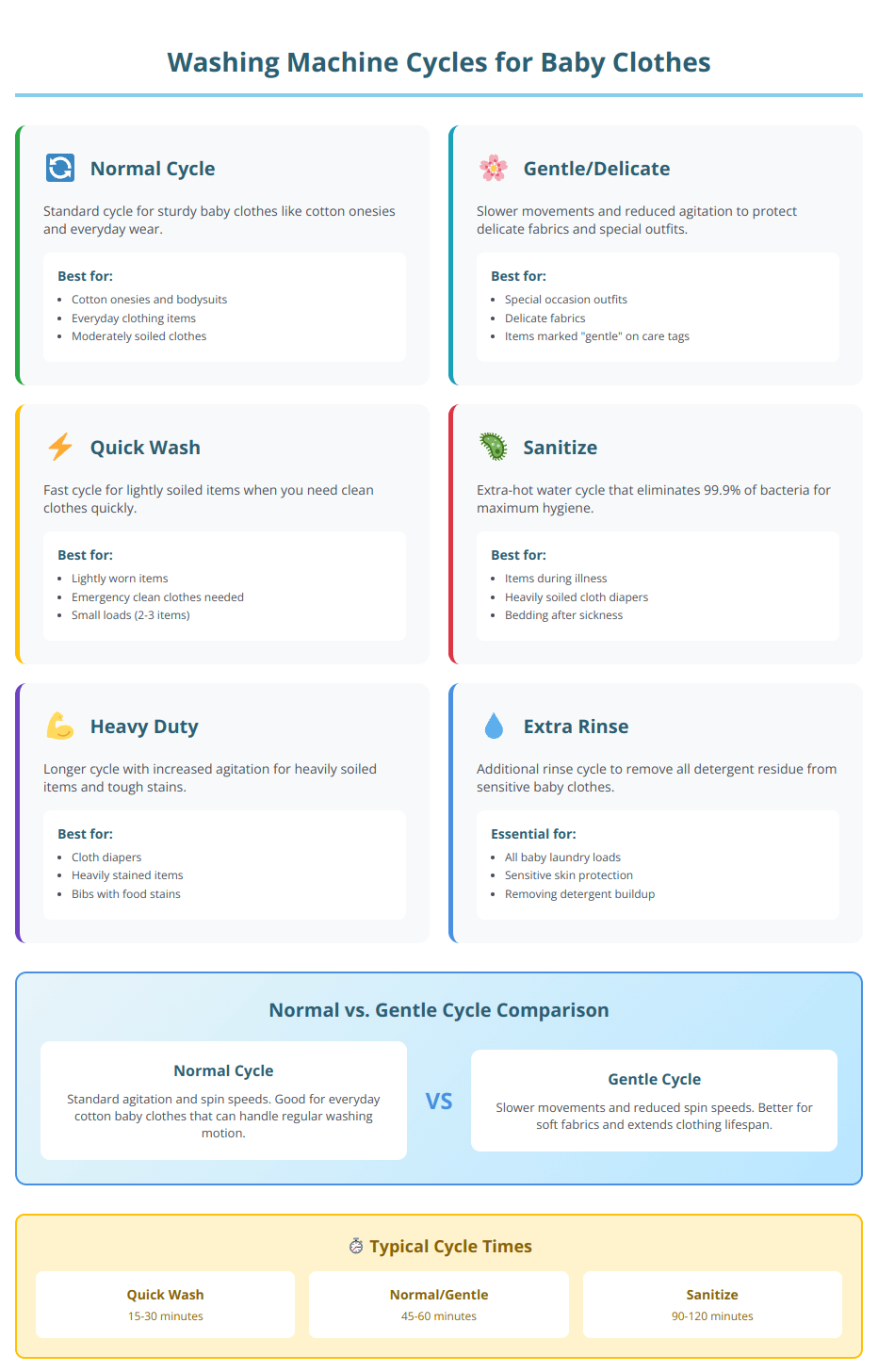
Choosing the right cycle for each type of baby clothing helps maintain quality while ensuring proper cleanliness.
Normal vs. Gentle Cycles
Normal Cycle: Appropriate for sturdy baby clothes like cotton onesies and everyday wear. Uses standard agitation and spin speeds.
Gentle/Delicate Cycle: Best for soft fabrics, special occasion outfits, or anything labeled "delicate" on the care tag. Uses slower movements to prevent damage.
Specialized Cycles for Baby Items
Quick Wash: Perfect for lightly soiled items that need rapid cleaning. Ideal when you're running low on clean clothes.
Heavy Duty: Use for heavily soiled items like cloth diapers or clothes with significant staining. Combines increased wash time with vigorous agitation.
Sanitize: Essential when dealing with illness or heavily contaminated items. Heats water to 150°F to eliminate bacteria effectively.
Hand Washing vs. Machine Washing
Choosing between hand washing and machine washing can be confusing for new parents. Here's a detailed comparison to help you decide:
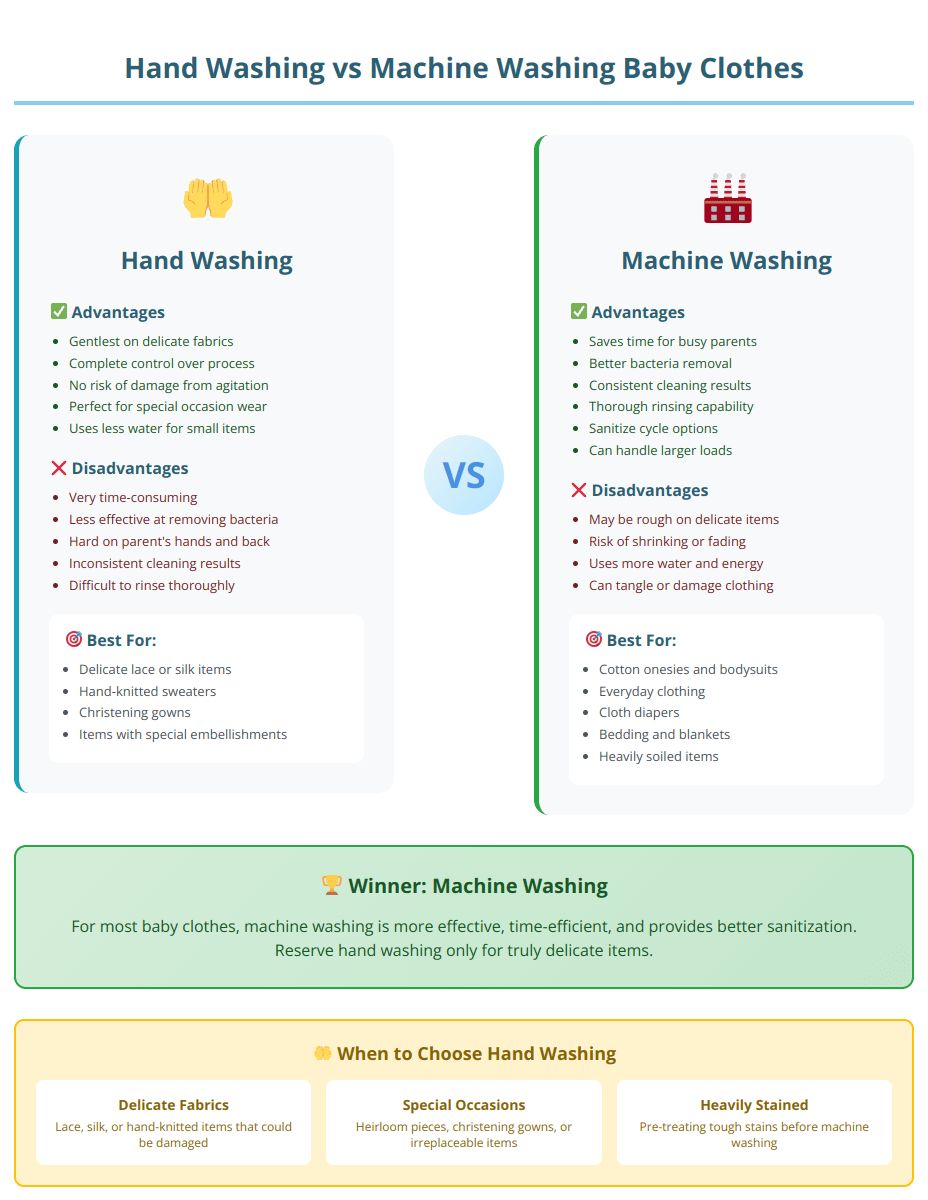
This comparison shows that while both methods have their place, machine washing is generally more practical and effective for most baby clothing needs.
When to Hand Wash Baby Clothes
Delicate Fabrics: Items made from lace, silk, or hand-knitted materials may require hand washing to prevent damage.
Special Occasion Wear: Christening gowns, heirloom pieces, or clothes with delicate embellishments need gentle hand care.
Heavily Stained Items: Sometimes pre-treating and hand washing provides better stain removal before machine washing.
Hand Washing Technique
- Fill a clean basin with lukewarm water
- Add a small amount of baby-safe detergent
- Gently swish clothes in the soapy water
- Let items soak for 30 minutes
- Rinse thoroughly until water runs clear
- Press (don't wring) excess water out
- Lay flat to dry to maintain shape
Is It Better to Hand Wash or Machine Wash?
Machine washing is generally better for most baby clothes because:
- More effective at removing bacteria and allergens
- Saves time for busy parents
- Provides consistent results
- Offers sanitization options not available with hand washing
Reserve hand washing for truly delicate items or when machine washing isn't available.
Maintaining Your Washing Machine for Baby Laundry
Proper maintenance ensures your washing machine provides safe, effective cleaning for your baby's clothes. Follow this comprehensive maintenance guide:
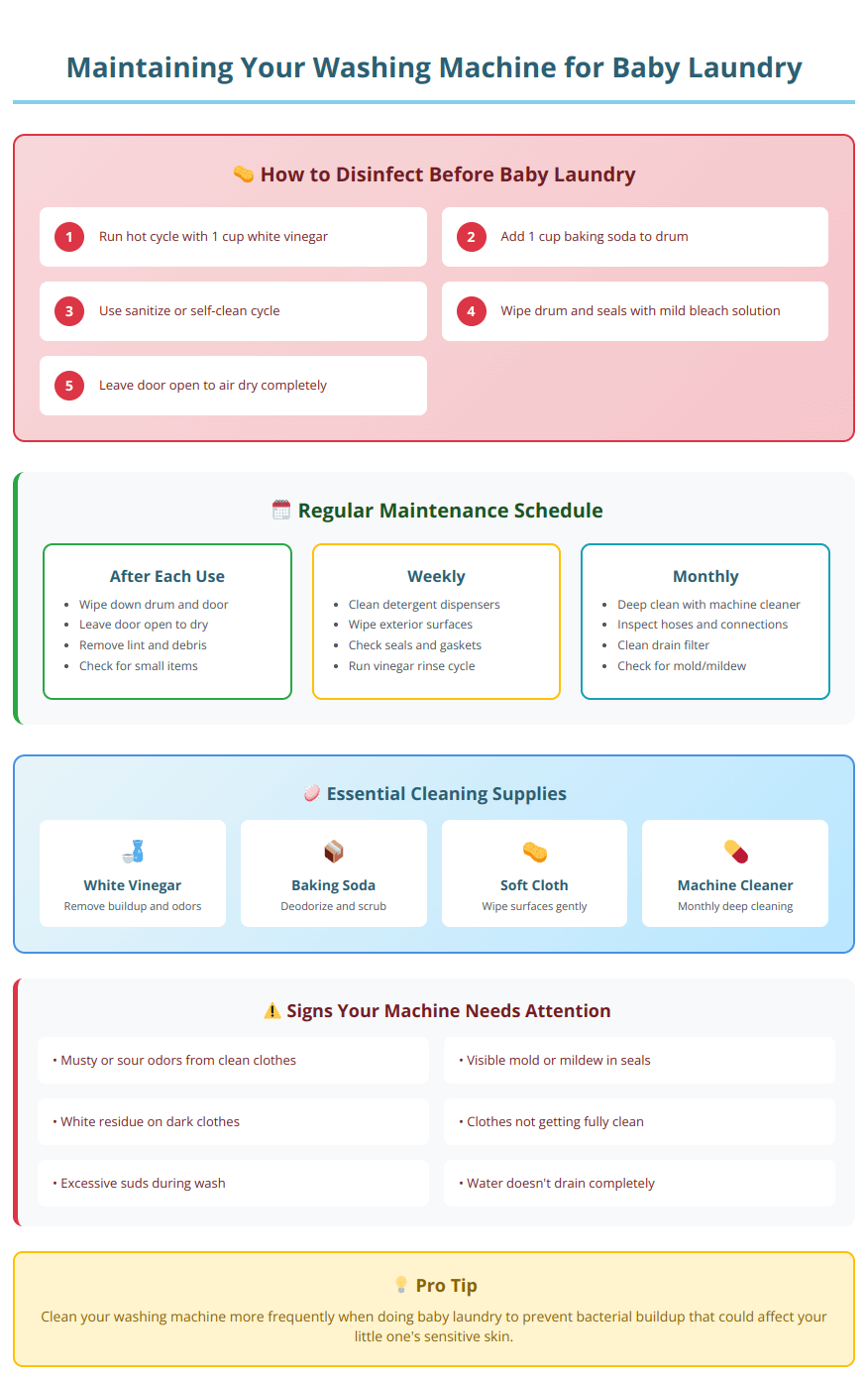
Regular maintenance not only extends your machine's life but also ensures it continues to provide the hygienic cleaning your baby's clothes require.
How to Disinfect Your Washing Machine
Before washing baby clothes, especially after illness or when starting to use the machine for baby laundry:
- Run a Hot Cycle: Use the hottest water setting with one cup of white vinegar
- Add Baking Soda: Sprinkle one cup of baking soda in the drum
- Use Sanitize Cycle: If available, run the machine's self-cleaning or sanitize cycle
- Wipe Down Surfaces: Clean the drum, door seal, and detergent dispensers with a mild bleach solution
- Leave Door Open: Allow the machine to air dry completely
Regular Maintenance Tips
- Monthly Deep Clean: Run an empty hot cycle with washing machine cleaner or vinegar to remove buildup.
- Check Seals and Gaskets: Clean these areas regularly as they can trap moisture and bacteria.
- Inspect Detergent Dispensers: Remove and clean thoroughly to prevent mold growth.
- Keep It Dry: Leave the door open after each use to prevent moisture buildup.
Troubleshooting Common Baby Laundry Issues
Even with the best intentions, laundry problems can arise. Here's how to identify and solve the most common baby laundry issues:
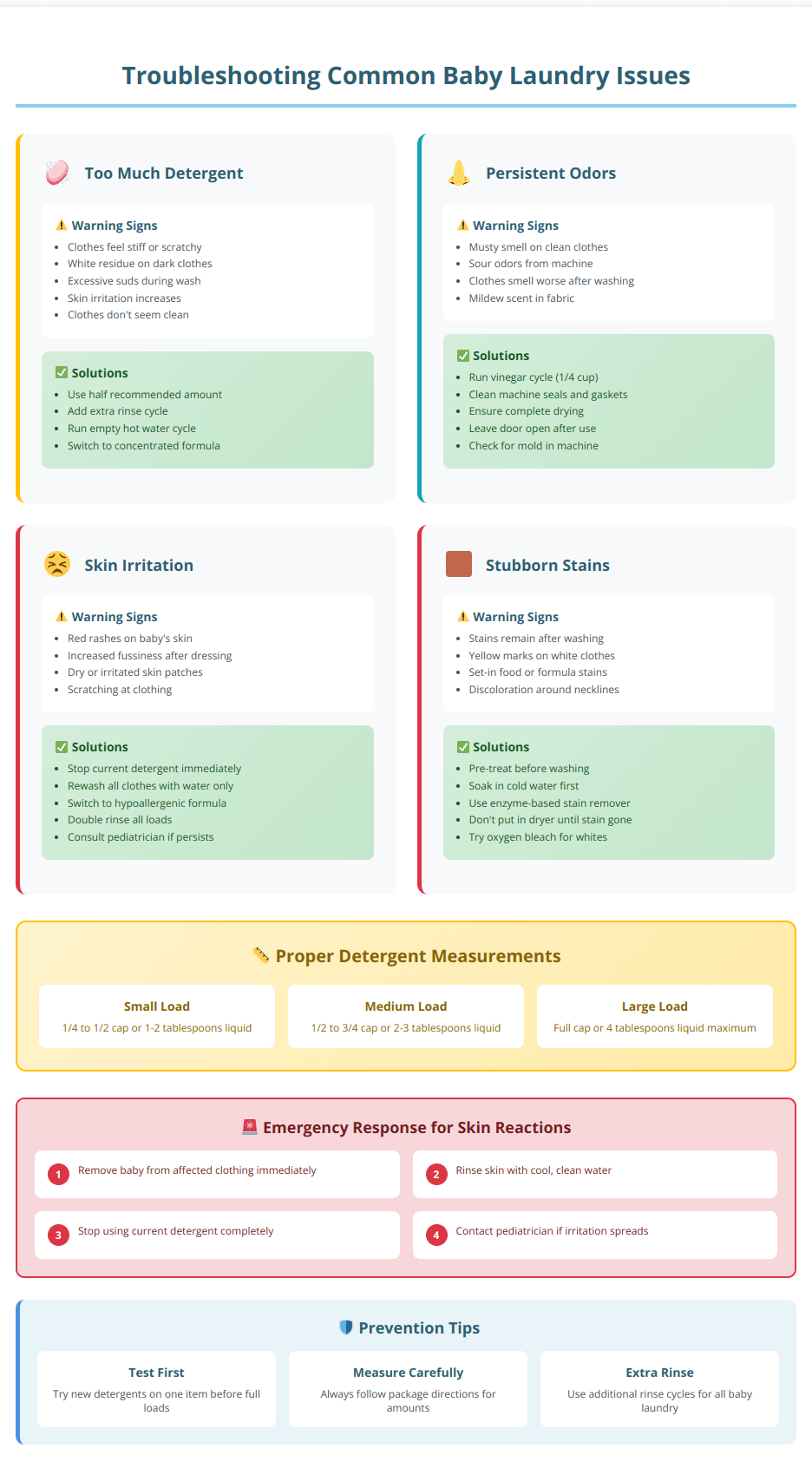
By recognizing these warning signs early and applying the right solutions, you can keep your baby's laundry routine running smoothly and safely.
Signs You're Using Too Much Detergent
- Clothes feel stiff or scratchy after washing
- White residue appears on dark clothes
- Skin irritation increases after wearing washed clothes
- Excessive suds during the wash cycle
- Clothes don't seem to get clean despite washing
Solution: Use half the recommended amount and add an extra rinse cycle.
Dealing with Persistent Odors
Cause: Usually detergent buildup or insufficient rinsing.
Solutions:
- Run clothes through an extra rinse cycle
- Wash with vinegar (1/4 cup) to break down residue
- Check your machine for mold or mildew
- Ensure clothes dry completely before storing
When Baby Develops Skin Irritation
Immediate Steps:
- Stop using current detergent
- Rewash all clothes with just water
- Switch to a different, gentler detergent
- Consult your pediatrician if irritation persists
Prevention:
- Always run extra rinse cycles
- Use minimal detergent amounts
- Choose certified hypoallergenic products
- Avoid fabric softeners and dryer sheets
Advanced Tips for Different Situations
Here are answers to the most common questions parents have about specific baby laundry situations:
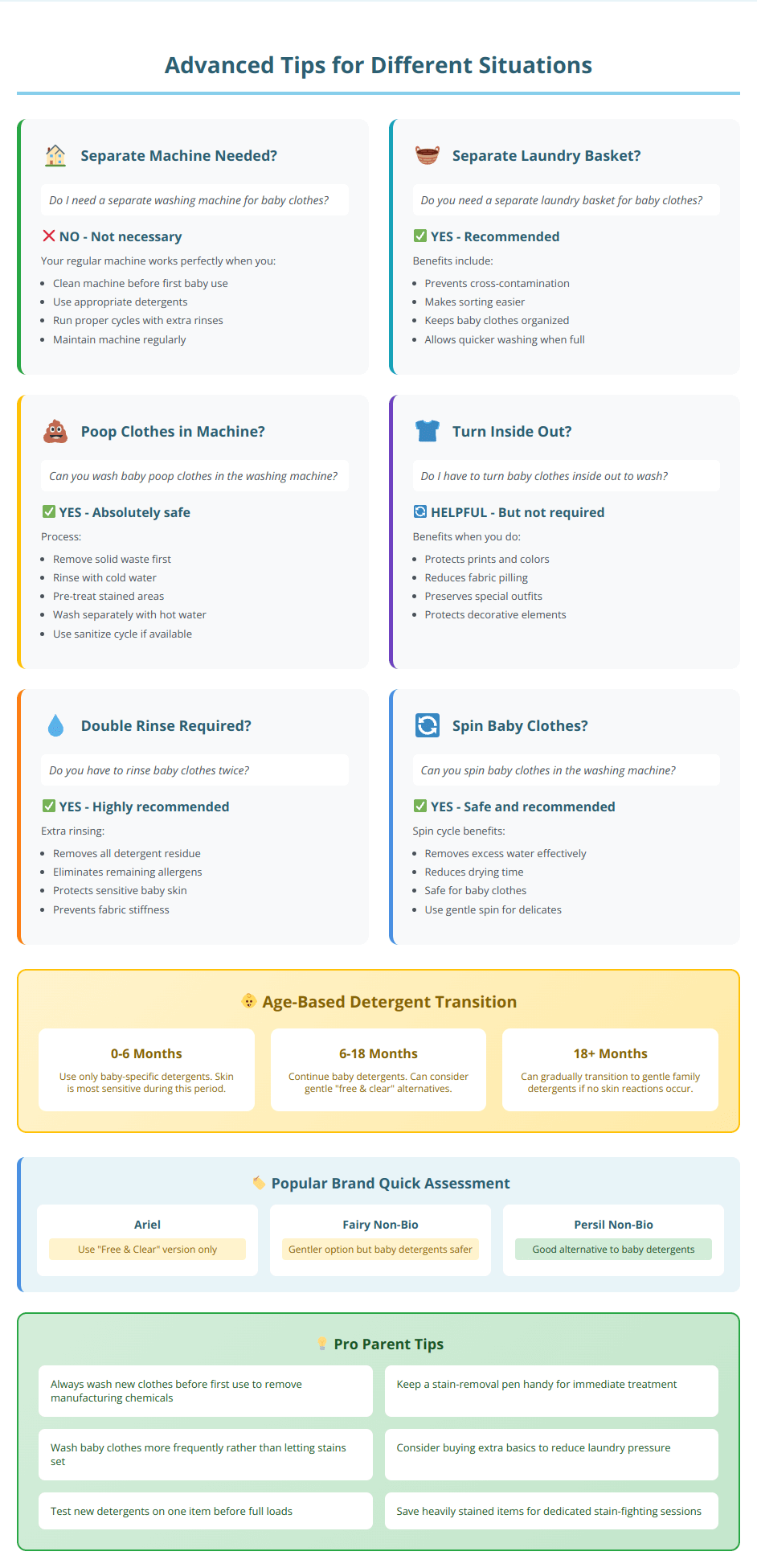
These advanced tips help you handle any baby laundry situation with confidence, ensuring safety and effectiveness in all scenarios.
Do I Need a Separate Washing Machine for Baby Clothes?
No, a separate machine isn't necessary. Your regular washing machine works perfectly for baby clothes when you:
- Clean the machine before first use for baby laundry
- Use appropriate detergents
- Run proper cycles with extra rinses
- Maintain the machine regularly
Do You Need a Separate Laundry Basket?
Yes, separate laundry storage helps by:
- Preventing cross-contamination with heavily soiled adult clothes
- Making sorting easier
- Keeping baby clothes organized
- Allowing for quicker washing when baskets fill up
Can You Wash Baby Poop Clothes in the Machine?
Absolutely. Modern washing machines handle heavily soiled baby clothes effectively:
- Remove Solid Waste: Scrape off excess material
- Rinse First: Use cold water to remove remaining residue
- Pre-treat: Apply detergent directly to stained areas
- Wash Separately: Use hot water and a sanitize cycle if available
- Double Rinse: Ensure all contaminants are removed
Do I Have to Turn Baby Clothes Inside Out?
It's helpful but not required. Turning clothes inside out:
- Protects prints and colors from fading
- Reduces fabric pilling
- Helps preserve the appearance of special outfits
- Protects decorative elements like buttons or appliques
Do You Have to Rinse Baby Clothes Twice?
Extra rinsing is highly recommended for baby clothes because:
- Removes all detergent residue that could irritate skin
- Eliminates any remaining allergens
- Ensures clothes are as pure as possible for sensitive baby skin
- Prevents buildup that can make clothes feel stiff
Most modern machines offer an "extra rinse" option that adds a second rinse cycle automatically.
Drying Baby Clothes
Choosing the right drying method is just as important as proper washing. Here's your complete guide to safely drying baby clothes:

Remember, when in doubt about drying any baby item, choose the gentler option to preserve the fabric and ensure your baby's safety.
Should You Tumble Dry Baby Clothes?
Yes, tumble drying is safe for most baby clothes when done correctly:
- Low Heat Settings: Use the lowest heat setting to prevent shrinking and fabric damage.
- Remove Promptly: Take clothes out as soon as they're dry to prevent over-drying and stiffness.
- Check Care Labels: Some delicate items may require air drying only.
Benefits of Machine Drying:
- Kills additional bacteria through heat
- Reduces wrinkles
- Saves time for busy parents
- Creates softer texture than air drying
Alternative Drying Methods
- Air Drying: Hang or lay flat for delicate items or when you want to preserve fabric integrity.
- Line Drying: Outdoor drying provides natural freshening and is environmentally friendly.
- Combination Method: Start with a short tumble dry cycle, then finish air drying to get benefits of both methods.
Creating a Baby Laundry Routine
An organized laundry routine makes managing baby clothes much easier for busy parents. Here's how to create an efficient system:
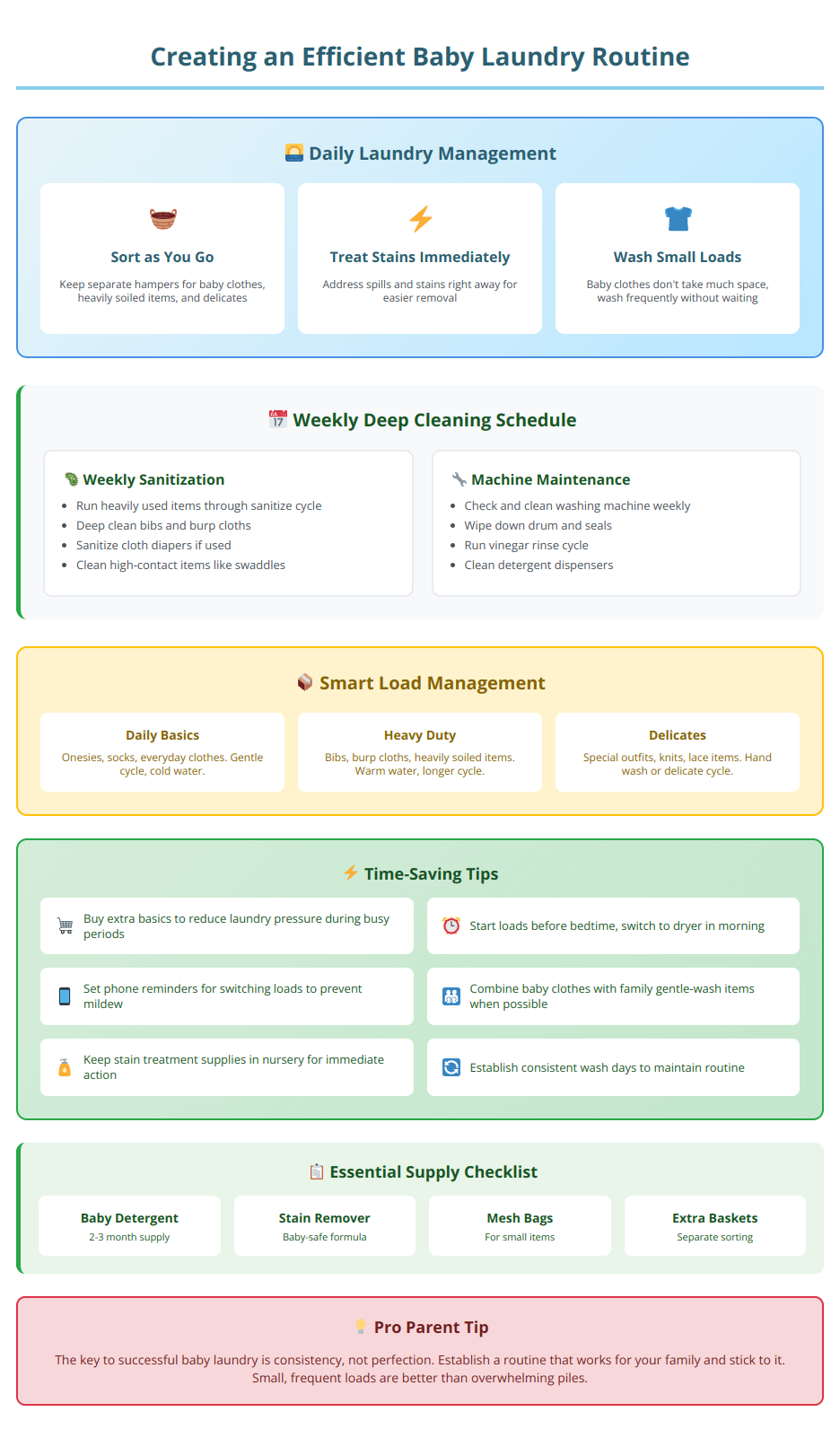
A well-planned routine reduces stress and ensures your baby always has clean, safe clothes available when needed.
Daily Laundry Management
- Sort as You Go: Keep separate hampers for baby clothes, heavily soiled items, and delicates.
- Treat Stains Immediately: Address spills and stains right away for easier removal.
- Wash Small Loads: Baby clothes don't take up much space, so you can wash frequently without waiting for large loads.
Weekly Deep Cleaning
- Sanitize Once Weekly: Run heavily used items through a sanitize cycle.
- Machine Maintenance: Check and clean your washing machine weekly when doing frequent baby laundry.
- Stock Check: Ensure you have adequate supplies of baby-safe detergent and stain treatments.
Safety Considerations
Safety should always be your top priority when caring for your baby's laundry. Here are the key safety considerations to keep in mind:
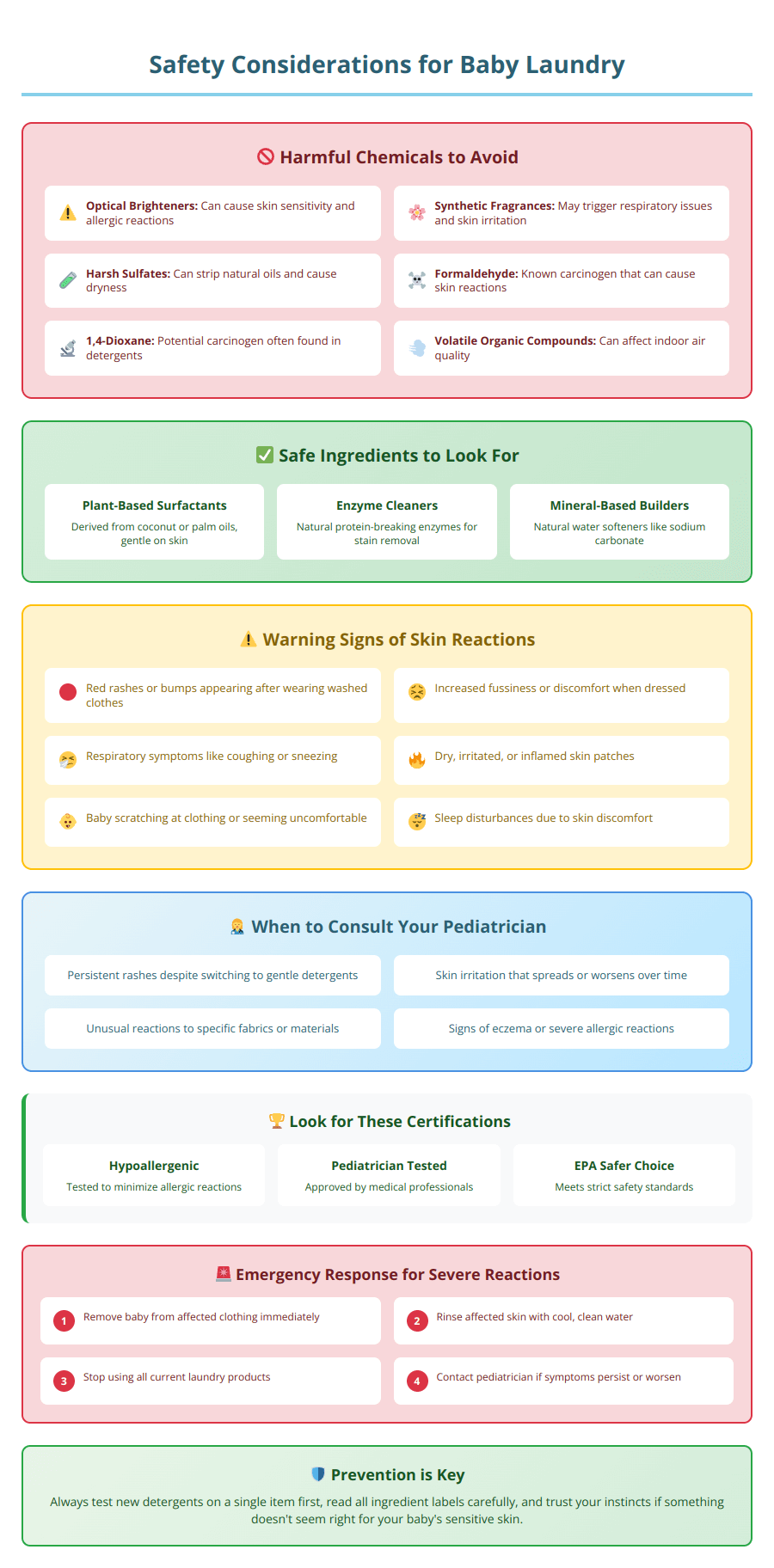
By following these safety guidelines and being aware of potential hazards, you can ensure your baby's laundry routine is both effective and safe.
Avoiding Harmful Chemicals
Read Labels Carefully: Look for products marked "baby-safe," "hypoallergenic," or "pediatrician-tested."
Avoid These Ingredients:
- Optical brighteners
- Synthetic fragrances
- Harsh sulfates
- Formaldehyde
- 1,4-dioxane
When to Consult Your Pediatrician
Contact your doctor if:
- Your baby develops persistent rashes after wearing washed clothes
- Skin irritation appears despite using gentle products
- You notice any unusual reactions to specific fabrics or detergents
Cost-Effective Baby Laundry Solutions
Keeping baby clothes clean doesn't have to break the bank. Here are proven ways to save money while maintaining safe, effective cleaning:
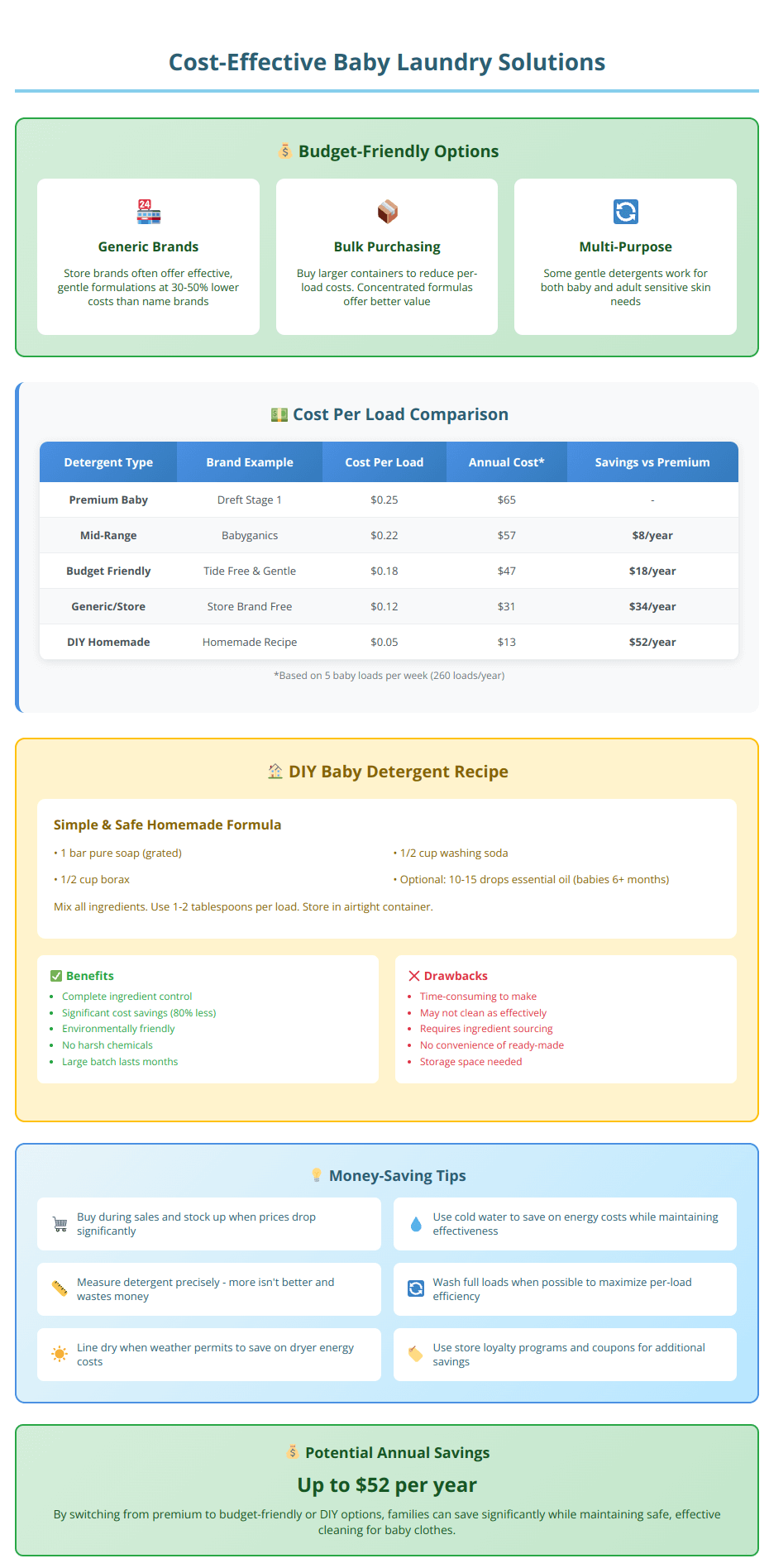
With these cost-effective strategies, you can provide excellent care for your baby's clothes while staying within your budget.
Budget-Friendly Options
- Generic Baby Detergents: Many store brands offer effective, gentle formulations at lower costs.
- Bulk Purchasing: Buy larger containers of proven detergents to reduce per-load costs.
- Multi-Purpose Products: Some gentle detergents work well for both baby and adult sensitive skin needs.
Making Your Own Baby Detergent
Simple Recipe:
- 1 bar pure soap (grated)
- 1/2 cup washing soda
- 1/2 cup borax
- Optional: 10-15 drops essential oil (only for babies over 6 months)
Benefits: Complete control over ingredients, significant cost savings, environmentally friendly.
Drawbacks: Time-consuming to make, may not clean as effectively as commercial products.
Environmental Considerations
Making environmentally conscious choices in your baby's laundry routine benefits both your child's health and the planet's future:

These environmental practices prove that caring for your baby and caring for the planet can go hand in hand, creating a healthier world for future generations.
Eco-Friendly Baby Laundry
- Cold Water Washing: Reduces energy consumption while still providing effective cleaning.
- Concentrated Detergents: Less packaging waste and often more effective per ounce.
- Line Drying: Eliminates energy use from dryers and provides natural freshening.
- Biodegradable Options: Choose detergents that break down safely in the environment.
Sustainable Practices
- Wash Full Loads: When possible, combine baby items with other gentle-wash items to maximize efficiency.
- Air Dry When Possible: Reduces energy consumption and extends fabric life.
- Choose Quality Over Quantity: Invest in well-made baby clothes that withstand frequent washing.
Frequently Asked Questions
Is it okay to wash newborn baby clothes in the washing machine?
Yes, washing machines are safe and effective for newborn clothes. Use gentle cycles, baby-safe detergents, and extra rinse cycles for best results.
Can you wash baby clothes on a regular cycle?
Regular cycles work for sturdy baby clothes like cotton onesies, but gentle cycles are better for delicate items and provide extra protection for all baby clothes.
Do I need a separate washing machine for baby clothes?
No, your regular machine works perfectly. Just clean it thoroughly before first use and maintain it properly for baby laundry.
What washing machine setting for baby clothes?
Use gentle or delicate cycles with cold or warm water, depending on soil level. Always include an extra rinse cycle.
What is the best newborn detergent?
Top choices include Babyganics Liquid, Dreft Stage 1, and Puracy Natural. Choose based on your budget and specific needs.
Do I need to wash baby clothes separately?
It's recommended to wash baby clothes separately from heavily soiled adult items, but you can combine them with other gentle-wash family laundry using baby-safe detergent.
Can you spin baby clothes in the washing machine?
Yes, the spin cycle is safe for baby clothes and helps remove excess water for faster drying.
Do I really need to wash newborn clothes?
Yes, always wash new baby clothes before first use to remove manufacturing chemicals and potential allergens.
Is fairy non-bio good for babies?
Fairy Non-Bio is gentler than regular Fairy, but specifically formulated baby detergents are still the safest choice for newborns.
Should you tumble dry baby clothes?
Yes, tumble drying is safe using low heat settings. It's often more convenient and hygienic than air drying.
Conclusion
Washing baby clothes in your washing machine is not only safe but often the most effective way to keep your little one's clothing clean, fresh, and free from harmful bacteria. The key to success lies in understanding the right techniques, choosing appropriate products, and maintaining consistent practices that protect your baby's sensitive skin.
Key Takeaways
- Your regular washing machine works perfectly for baby clothes when used with proper settings and detergents. You don't need special equipment, just the right knowledge.
- Gentle detergents make the difference. Invest in quality, baby-safe products like Babyganics, Dreft, or Puracy that are specifically formulated for sensitive skin. The extra cost pays off in your baby's comfort and health.
- Water temperature matters. Cold water handles most baby laundry effectively while preserving fabrics and colors. Use warm water for heavily soiled items and reserve hot water for sanitizing when needed.
- Extra rinse cycles are essential. This simple step removes detergent residues that could irritate your baby's skin and ensures clothes are as pure as possible.
- Machine features enhance safety. Take advantage of sanitize cycles, gentle settings, and steam options that modern machines offer for superior cleaning and bacteria elimination.
- Preparation prevents problems. Always wash new clothes before use, treat stains promptly, and sort laundry appropriately to avoid color bleeding and damage.
- Maintenance matters. Keep your washing machine clean and well-maintained to ensure it continues providing safe, effective cleaning for your baby's clothes.
Final Recommendations
Start with a high-quality, baby-specific detergent and stick with it unless you notice skin reactions. Establish a routine that includes immediate stain treatment, appropriate sorting, and consistent use of gentle cycles with extra rinses. Don't overthink the process – millions of parents successfully wash baby clothes in regular machines every day.
Remember that as your baby grows, their skin becomes less sensitive, and you can gradually transition to gentler versions of regular detergents. Until then, following these guidelines will ensure your baby's clothes are clean, safe, and comfortable.
To make your baby laundry routine even more effective, check out our interactive tools: compare detergents with our Detergent Comparison Chart, find the perfect temperature with our Temperature Selection Guide, for comprehensive stain removal guidance, don't miss our Stain Identification and Treatment Guide which provides expert techniques for every type of baby-related stain you'll encounter, and ensure your machine is baby-ready with our Compatibility Checker.
The investment in proper baby laundry care pays dividends in your child's health, comfort, and your peace of mind. With the right approach, washing baby clothes becomes just another manageable part of parenthood rather than a source of worry.

